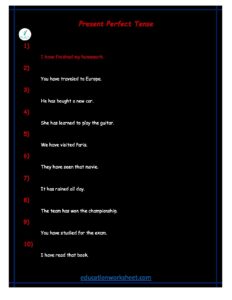how to converting Present Continuous Tense negative sentences to interrogative form
how to converting Present Continuous Tense negative sentences to interrogative form
The Present Continuous tense is a fundamental aspect of English grammar used to describe actions that are happening at the current moment or around the time of speaking. To create sentences in this tense, you typically start with a subject, followed by the auxiliary verb “am,” “is,” or “are,” and then the main verb in its present participle form (-ing form). However, you might find it necessary to transform negative sentences in the Present Continuous tense into interrogative (question) form for various reasons, such as seeking information or clarification. In this comprehensive guide, we will explore how to convert Present Continuous tense negative sentences into interrogative sentences effectively.
Understanding the Present Continuous Tense

Before diving into the conversion process, let’s review the basic structure of a sentence in the Present Continuous tense:
- Affirmative sentence: Subject + am/is/are + verb + -ingExample: She is reading a book.
- Negative sentence: Subject + am/is/are + not + verb + -ingExample: They are not playing tennis.
how to converting Present Continuous Tense negative sentences to interrogative form
The negative sentence uses “not” after the auxiliary verb “am,” “is,” or “are” to negate the action. Now, we will explore how to transform these negative sentences into interrogative sentences.
Converting Negative Sentences to Interrogative Sentences
To convert Present Continuous tense negative sentences into interrogative sentences, you need to follow these steps:
- Swap the Subject and Auxiliary Verb
In an interrogative sentence, the subject and the auxiliary verb (am/is/are) are switched places. This reversal signals that the sentence is a question.
Original Negative Sentence: They are not playing tennis.
Interrogative Transformation: Are they not playing tennis?
In the interrogative form, the subject “They” and the auxiliary verb “are” have switched places.
- Use Question Words
To make the interrogative sentence more specific or to seek particular information, you can incorporate question words like “who,” “what,” “where,” “when,” “why,” and “how.” These question words help you frame questions effectively.
Original Negative Sentence: She is not watching TV.
Interrogative Transformation: Is she not watching TV?
Interrogative Transformation with Question Word: Why is she not watching TV?
In the second example, the question word “why” is added to seek the reason behind the action.
- Maintain Verb-Auxiliary Agreement
When converting negative sentences to interrogative ones, ensure that the auxiliary verb (am/is/are) still agrees with the subject in terms of number and person.
Original Negative Sentence: They are not studying for the test.
Interrogative Transformation: Are they not studying for the test?
In this case, “are” agrees with the subject “They.”
- Use the Appropriate Question Mark
Finish your interrogative sentence with a question mark (?) to indicate that it is a question. This punctuation mark is crucial in distinguishing questions from statements.
Original Negative Sentence: He is not playing football.
Interrogative Transformation: Is he not playing football?
With these fundamental steps in mind, let’s explore some practical examples of converting Present Continuous tense negative sentences into interrogative sentences.
Special Cases: Wh-Questions:
In addition to simple yes/no questions, you can also form interrogative sentences in the present continuous tense using wh-questions (questions that start with words like “what,” “where,” “when,” “why,” “who,” and “how”). To create wh-questions, follow these steps:
Step 1: Identify the Wh-Question Word:
Identify the wh-question word (e.g., what, where, when, why, who, how) that you want to use in your question.
Step 2: Place the Wh-Question Word at the Beginning:
Put the wh-question word at the beginning of the sentence.
Step 3: Follow the Regular Interrogative Structure:

Continue with the regular interrogative structure by adding the auxiliary verb, subject, verb+ing phrase, and question mark.
Let’s see some examples:
- Negative Sentence: They are not going to the party. Wh-Interrogative Form: Where are they going?
- Negative Sentence: She is not studying for the test. Wh-Interrogative Form: Why is she not studying for the test?
how to converting Present Continuous Tense negative sentences to interrogative form
Practice Exercises:
To reinforce your understanding, here are some practice exercises. Try converting the following negative sentences into interrogative form:
- Negative Sentence: He isn’t watching the movie. Interrogative Form: ________?
- Negative Sentence: They aren’t playing soccer. Interrogative Form: ________?
- Negative Sentence: I’m not eating pizza for dinner. Interrogative Form: ________?
- Negative Sentence: She isn’t listening to music right now. Interrogative Form: ________?
- Negative Sentence: We aren’t going on vacation this summer. Interrogative Form: ________?
how to converting Present Continuous Tense negative sentences to interrogative form
Conclusion:
Converting present continuous tense negative sentences into interrogative form is a fundamental skill in English grammar. By following the steps outlined in this guide and practicing with examples, you can become proficient at forming questions in the present continuous tense. Whether you’re having a conversation, writing, or taking an English exam, mastering this skill will help you effectively communicate and understand spoken and written English. Keep practicing and experimenting with different sentences to build your confidence and fluency in using the present continuous tense in interrogative form.

